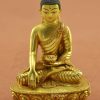Our small Shakyamuni statue is using the classic “Bhumisparsha mudra”. This mudra depicts the moment that the Buddha vanquished the demon Mara and obtained enlightenment. The Bhumisparsha mudra is also known as “calling the earth to witness”. This is because when the Buddha was on the verge of enlightenment, he was tempted by a demon known as Mara. However, the treasure and beautiful women were not enough to dissuade the Buddha from his goal. The earth touching mudra is a gesture of triumph. As a result of Mara’s defeat, the Buddha called on the Earth Goddess to witness his victory.
Small Shakyamuni Statue Symbols
Shakyamuni Buddha was born in the 6th century BCE. He was born as a Prince in the Shakya Kingdom named as Siddhartha Gautama. As a result, Shakyamuni Buddha statues usually portray him wearing the ushnisha. This is because it was a common head dress worn by Hindu royalty. However, after Prince Siddhartha renounced his kingdom it is believed that he no longer wore it.
These three neck lines were also a sign of beauty and prestige in ancient India. So in that sense they are similar to the ushnisha. However, they also draw attention to the Buddha’s throat. As a result, it is a symbol that acknowledges the melodious nature of the Buddha’s voice. Additionally, it symbolizes the harmony and the endless knowledge contained in the Dharma teachings. Click here to learn more about the origin of Buddhism.










